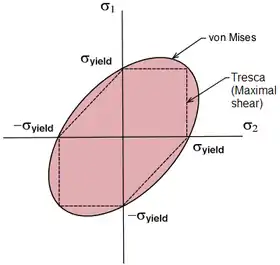Henri Tresca | |
|---|---|
 | |
| Born | 12 October 1814 |
| Died | 21 June 1885 (aged 70) Paris |
| Nationality | French |
| Occupation | Engineer |
| Engineering career | |
| Discipline | Mechanical |
| Institutions | American Society of Mechanical Engineers, French Academy of Sciences |
Henri Édouard Tresca (12 October 1814 – 21 June 1885) was a French mechanical engineer, and a professor at the Conservatoire National des Arts et Métiers in Paris.
Work on plasticity
He is the father of the field of plasticity, or non-recoverable deformations, which he explored in an extensive series of experiments begun in 1864. He stated one of the first criterion of material failure, that now brings his name. The criterion specifies that a material would flow plastically if

Tresca's criterion is one of two main failure criteria used today for ductile materials. The second important criterion is due to Richard von Mises. See comparison on the image left:
Design of the International Prototype Metre

Tresca was also among the designers of the prototype metre bar that served as the first standard of length for the metric system. After the Convention of the Metre had been signed in 1875, the International Bureau of Weights and Measures (BIPM) in Sèvres, France made 28 prototype line standards of platinum-iridium. The bars had a cross section shaped like a modified letter X, designed by Tresca, called the "Tresca section". The Tresca section was designed to provide maximum stiffness. In addition, one surface of the central rib that joined the arms was designed to coincide with the bar's neutral plane, the mathematical plane inside the bar that didn't change length when the bar bent. The two marks near each end of the bar which defined the meter were ruled on this surface. Thus, to first order, the distance between the marks wouldn't change due to the slight sagging of the bar under its own weight between support points. One of the bars was selected as the International Metre. The United States received National Prototype Metres No. 27 and No. 21 in 1890. When the Mendenhall Order in 1893 declared the meter to be the fundamental length standard, No. 27 became the US primary national standard for all length measurements. It remained so until 1960.[1]
Recognition
Tresca was made an honorary member of the American Society of Mechanical Engineers in 1882.[2]
Tresca's stature as an engineer was such that Gustave Eiffel put his name on number 3 in his list of 72 people making the Eiffel tower in Paris possible.
See also
References
- ↑ "National Prototype Meter No. 27". Archived from the original on 2008-09-16.
- ↑ "Honorary Member". www.asme.org. Retrieved 2019-11-21.
External links
- Henri Tresca in Technische Mechanik für Ingenieure
- [Henri] Tresca, Appendix C: Note on the form which it is advisable to adopt for the metres to be constructed by the International Commission, pp 77-93, in Second Report of the Commissioner of Inland Revenue of the Inspection of Weights, Measures and Gas, in Sessional Papers, Volume 2, Second Session of the Third Parliament of the Dominion of Canada, Session 1875, Volume VIII (English translation of Tresca's French paper on Tresca section)